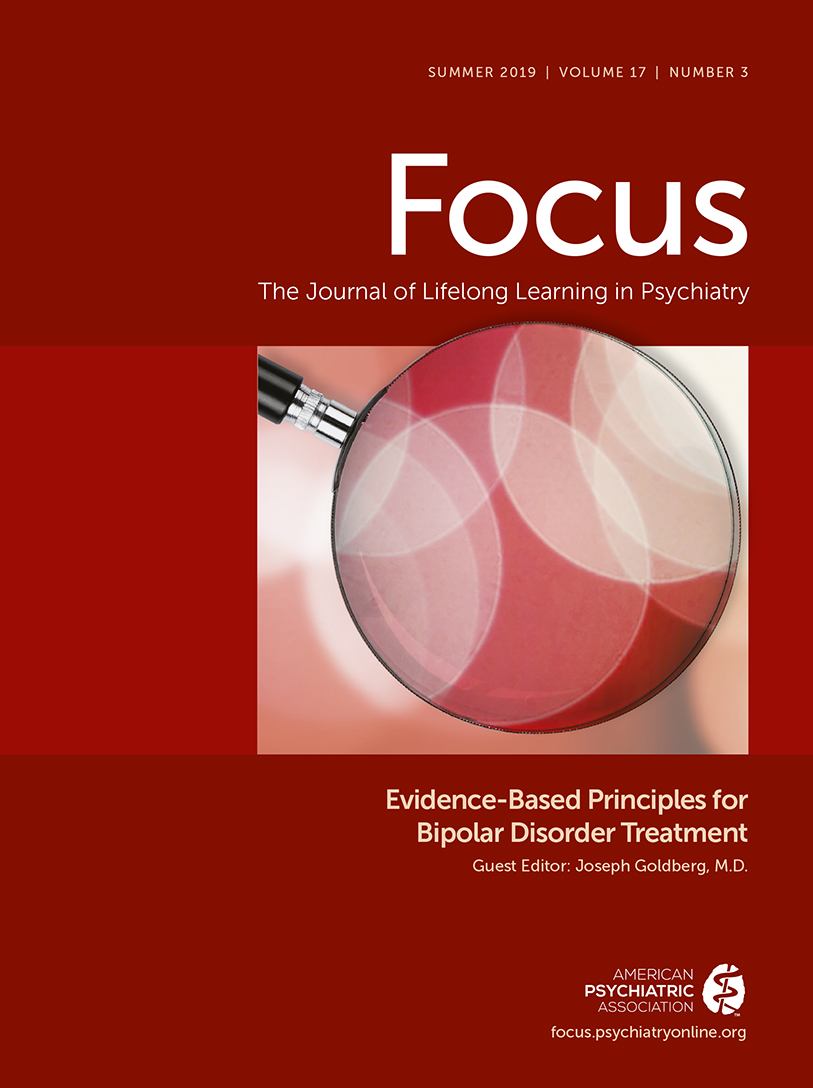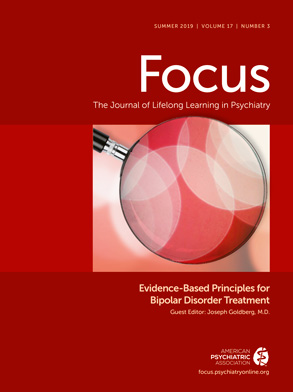Medicine is an art whose magic and creative ability have long been recognized as residing in the interpersonal aspects of patient-physician relationship.
—Judith A. Hall, Debra L. Roter, and Cynthia S. Rand (
1)
Bipolar disorder is a severe, recurrent, and chronic disorder, with attendant morbidity and mortality (
2). Suicide rates among people with bipolar disorder are 12 times higher than those in the general population (
3). The functional disability that individuals experience from this disorder varies widely.
Medications and psychosocial interventions are often very effective in managing symptoms and minimizing the suffering associated with this disorder (
2). As with other chronic illnesses, following an effective treatment regimen is necessary for optimal prognosis. However, adherence to medication is a common problem in bipolar disorder, and one that contributes substantially to poor outcomes (
3,
4). Despite the increase in the number of effective medications, the efficacy-effectiveness gap in clinical practice suggests that lack of adherence is a major problem in the treatment of bipolar disorder and contributes substantially to functional disability and even death (
3–
5).
Hassan and colleagues noted that “the quality of the professional-patient relationship in the treatment of mental illness predicts patient outcomes” (
6). A collaborative relationship in the treatment of individuals with psychiatric disorders has been found to predict treatment outcomes across a range of therapeutic settings (
7). This may be particularly important for successfully engaging patients who have previously demonstrated reluctance to engage in mental health services (
8).
In fact, in the Treatment of Depression Collaborative Research Program (
9), the therapeutic alliance was associated with a higher variance in outcome (21%) compared with any specific psychotherapy or pharmacotherapy. Study authors posited that the therapeutic relationship may be a nonspecific, positive factor in treatment response. In addition, this alliance may provide a “holding environment” in which issues related to taking medication can be addressed (
9). Likewise, the National Depression and Manic-Depression Association survey (
10) reported that patients who were more satisfied with their provider were able to come to terms with their illness more readily, felt more able to cope with their illness, were less angry and ashamed about the illness, and were more likely to adhere to their medication regimen. The connection with the patient and hope that the clinician conveys may be communicated to the patient in a sustaining manner.
In a study of patient experience by Bilderbeck et al. (
11), individuals with symptoms of unstable mood described the importance of receiving an explanation for their symptoms. They also noted the value of having a collaborative relationship with their clinicians, of being listened to and acknowledged, and of being informed about and involved in clinical decisions regarding their care. These authors highlighted the importance of eliciting the patient’s goals and values regarding his or her care in the development of a strong therapeutic relationship. Effective and collaborative doctor-patient communication improves outcomes (
6,
12–
14).
Balán, Moyers, and Lewis-Fernández (
15) described a therapeutic approach—motivational pharmacotherapy—that improves medication adherence and incorporates elements of motivational interviewing into a standard pharmacotherapy session. Motivational pharmacology uses four central processes: engaging the patient, focusing on the patient’s desired behavior change, evoking and reinforcing the patient’s own stated reasons for wanting to change, and planning steps to achieve this goal. According to Lewis-Fernández, “by eliciting and responding to ‘change talk,’ Motivational Pharmacotherapy reshapes the physician-patient interaction from an assessment of symptoms and side-effects to a conversation about the patient’s treatment experience, treatment goals, and progress toward those goals. In this format, the physician and patient are equal co-decision makers” (
16).
The basic frame of motivational pharmacotherapy begins with the psychiatrist welcoming the patient, affirming the commitment to treatment, and suggesting a brief overview of the forthcoming session. The psychiatrist asks directly about what steps the patient has taken to stay adherent to the treatment and what obstacles may be interfering with optimal adherence. The patient is encouraged to suggest strategies he or she may use to improve adherence. The session wraps up with a review of the treatment regimen and a collaborative decision about any changes to the medication treatment. It is also critical to ensure that the motivational pharmacotherapy is culturally congruent with the patient’s worldview, hopes, and fears.
Clinical Vignette
Dr. Valdez knew Ms. Smith well. They had been working together for the past year. He had noted and they had discussed how her clothing, makeup, and presentation reflected her mood. Bright red lipstick, too much eye makeup, and more revealing clothing meant Ms. Smith was getting manic. Less makeup with dark clothing meant she was more depressed. Today, she presented as well groomed and casually dressed. Her makeup was tasteful.
“Good to see you. Come right in,” Dr. Valdez said, smiling warmly, relieved and pleased that Ms. Smith looked so healthy.
“Yes, I really am doing better,” Ms. Smith said with a grin, noting Dr. Valdez’s relief. “I have gotten to work every day, and my boss even complimented me on my last report. My sleep has been better, too. I think that having a routine is helping me—exercise, too. I’m going to the spin class at the gym.”
Dr. Valdez did not hide his delight. “Great! So your motivation has improved so much that you are really able to do the things you have wanted to do. What helped you make these positive steps?”
Ms. Smith contemplated this briefly. “I think that when I see that I am looking and functioning better, it keeps me motivated. I used to spend all of my energy worrying that I would get fired from my job. I did get fired from one, as you know. Right now, I actually have some self-confidence, and it really helps.”
“Have you noticed any problems with your treatment?” Dr. Valdez inquired.
“The usual dry mouth and needing to get up to go to the bathroom at night. Nothing I can’t manage. And, yes, I am taking the medication every day.”
“Good. I give you a lot of credit. You identified your goals and keep moving forward to achieve them—even when it gets hard.”
Dr. Valdez and Ms. Smith reviewed her goals, the steps she is taking to achieve these goals, and methods to manage the inevitable “bumps in the road of life.”
“I haven’t thrown out my red lipstick, but I only wear it when I go out at night—okay?” Ms. Smith quipped, referring to their discussions about how her mood and appearance correspond.
“Perfect—keep up the good work,” Dr. Valdez replied. “See you next time.”
Tips for Enhancing Engagement With Individuals in Treatment for Bipolar Disorder
1.
Welcome the patient warmly each visit.
2.
Highlight from the first interactions the importance of honesty and trust (on both sides) in the therapeutic relationship, specifying clearly the treatment approach, areas of choice, limits of confidentiality, and safety management plans.
3.
Listen carefully to the patient’s aspirations, beliefs, and concerns, and acknowledge these regularly.
4.
Help the patient clarify desired life goals and the behavior change required to reach those goals.
5.
Support “change talk,” in which the patient discusses his or her reasons for wanting to change and perception of his or her ability to change.
6.
Reinforce that your role as physician or clinician is to support the healthy change that the patient desires.
7.
Explicitly state that decisions are made are jointly, and encourage the patient to discuss methods of feeling more empowered.
8.
Be realistic. Help the patient take on small and achievable goals. Success is the best motivator. Predict “bumps in the road,” and normalize them to decrease the risk of a sense of failure if a patient doesn’t meet his or her goals.
9.
Write down the specific steps the patient has decided to take between sessions. This can be motivating and allows discussion of what went well and what didn’t.
10.
Inquire about treatment adherence and what helped or hindered this.
11.
Specify a safety plan, ask regularly about safety (e.g., presence of weapons, pills, etc., in the home), and review the coverage and plan for the patient if he or she is not feeling safe.
12.
Acknowledge your appreciation of the patient’s honesty and efforts toward illness management.
13.
Work in a collaborative team whenever possible, with regular and specified methods of team communication. Integrate the patient into these discussions whenever possible.

